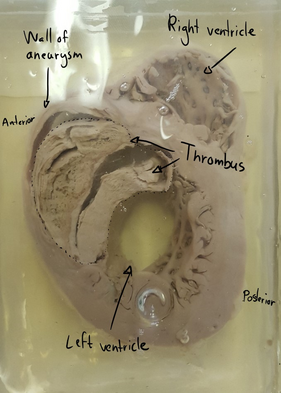43. Aneurysma thrombotisatum ventriculi sinistri cordis
Organ: Heart
Description:
The anterior wall of the left ventricle is very thin and is bulging out. The aneurysm contains a large thrombus that has been split into two parts.
Diagnosis: Previous myocardial infarct with aneurysm and thrombus
Causes:
- Previous (chronic) myocardial infarct
Theory:
In this case did the patient previously have a transmural anterior myocardial infarct. This infarct healed successfully, so the wall is replaced with scar tissue (fibrosis). This makes the wall weaker than the healthy myocardial wall, meaning that the wall is prone to form an aneurysm. Note how thin the wall of the aneurysm is.
If an aneurysm forms will the blood flow inside the aneurysm be turbulent, which promotes thrombosis formation, which is what has occurred in this preparation. The thrombus has Zahn lines (although they’re hard to see in this preparation). The thrombus has split along one of the Zahn lines into two parts.
Aneurysm in the left ventricle can have two dangerous fates. The thin aneurysm wall can rupture, leading to blood leaking out of the ventricle into the pericardial sac, forming a pericardial tamponade that can cause diastolic heart failure. The other fate is what occurred here: thrombosis. However, the thrombus could loosen and cause embolization as well.

